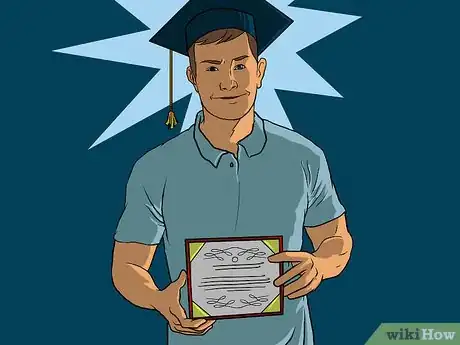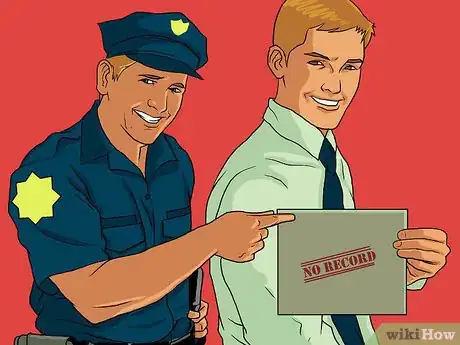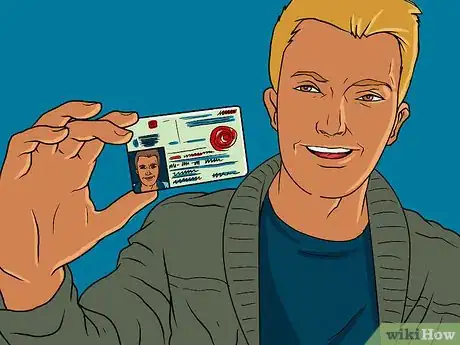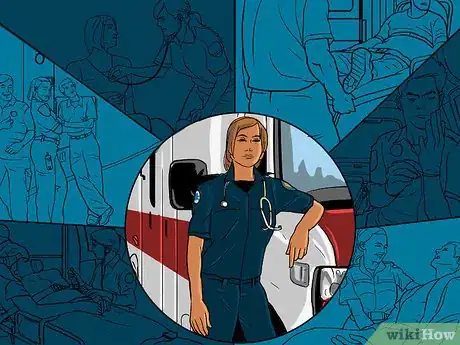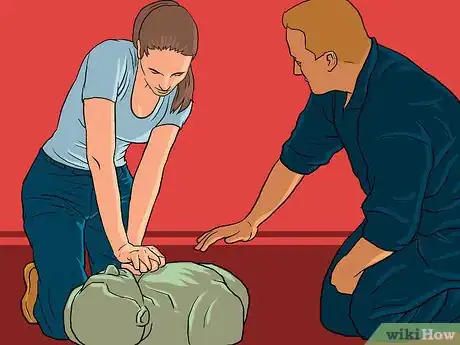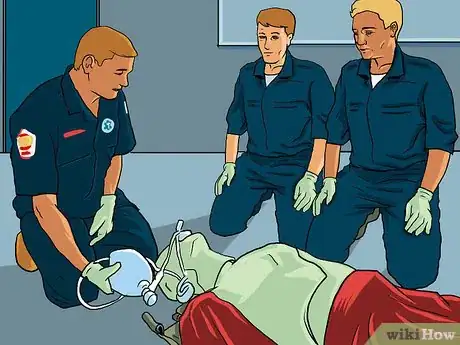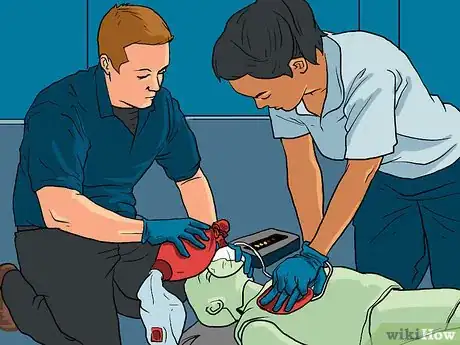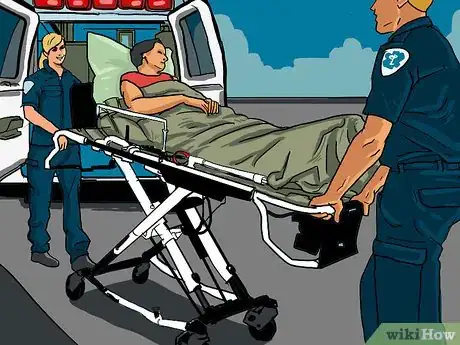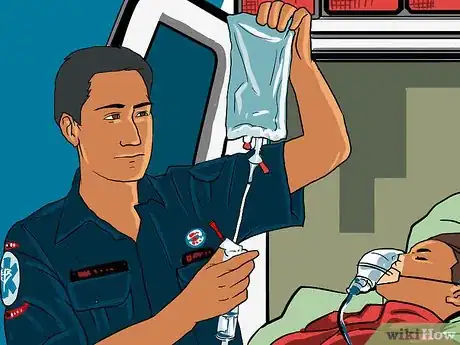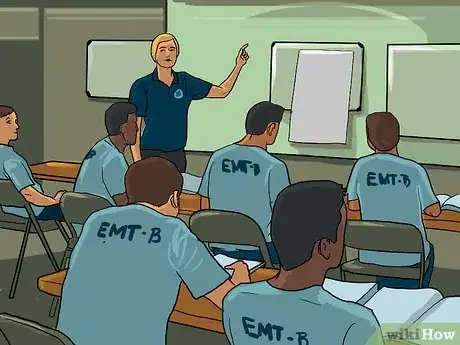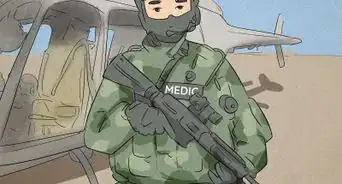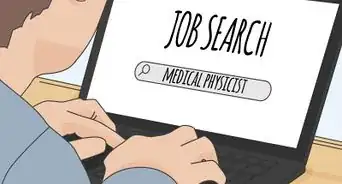wikiHow is a “wiki,” similar to Wikipedia, which means that many of our articles are co-written by multiple authors. To create this article, 47 people, some anonymous, worked to edit and improve it over time.
This article has been viewed 670,168 times.
Learn more...
Paramedics have a rewarding, coveted job that has a 33% job growth rate predicted by 2020.[1] However, to be a paramedic, you have to put in long hours during training, be quick on your feet, and help patients as quickly as possible while staying calm. If you want to know how to become a paramedic, follow these steps.
Steps
Meeting the Requirements
-
1A high school diploma or a GED. If you want to be a paramedic, you have to meet this basic requirement for schooling. If you're interested in being a paramedic, you should study courses related to the field, such as anatomy and physiology. Once you advance far enough in the paramedic training process, take college courses such as biology and anatomy. If you have a B.A. or have taken these courses, you will have a leg up.[2]
- If you're really determined to be a paramedic right out of high school, though, there's nothing stopping you.
-
2Have a clean record. That's right. Before you can be a paramedic, you'll need to pass a background check so you can't have any felonies in your background. Being in trouble with the law for drug use or other crimes can keep you from being a paramedic. Paramedics need to demonstrate strong character and a respect for the law.Advertisement
-
3Be at least eighteen years old. This shouldn't be a problem since you will probably be eighteen or close to it after you graduate high school anyway.[3]
-
4Have the qualities of a paramedic. Though you can work to develop the qualities you really need to be a paramedic, if you have them up front, you will be a stronger candidate and will be more mentally and physically prepared for dealing with the job. Here are the skills that you should have and develop.[4]
- Compassion. You'll have to offer emotional support to patients in extreme situations.
- Interpersonal skills. You'll also have to get along with your fellow team members to get the job done.
- Listening skills. This skill will help you understand the extent of your patients' injuries.
- Strength. You'll be doing plenty of lifting, bending, and kneeling for this job, so you have to be fit.
- Problem-solving skills. The solution to a patient's problem won't usually be obvious.
- Communication skills. You'll need to clearly explain procedures to a patient and to communicate and give and receive orders within your team.
-
5Speak a foreign language (optional). Though speaking Spanish or another language that is commonly spoken in your community won't guarantee you a job, it will give you a major leg up in the application process. Many paramedics do not speak a foreign language, so if you're one of the few applicants in your area who speaks a language that is common there, your resume will rise to the top.
Getting Certified
-
1Get certified in CPR. This is required for an EMT-Basic class. Check first with the EMT course instructor or school, as CPR certification may be part of the class. If not, the Red Cross, American Safety and Health Institute, American Heart Association, and Wilderness Medical Associates all offer relatively inexpensive CPR classes, but entry into a paramedic program will give preference to the American Heart Association Healthcare Provider Card.
-
2Get your EMT-Basic certification. This is a must for becoming a paramedic. There are four levels of EMT:
- E.M.R (Emergency Medical Responder) also known as a First Responder
- EMT-B (Emergency Medical Technician Basic) This is the certification that is commonly referred to as an EMT
- A.E.M.T (Advanced Emergency Medical Technician) Also known as Intermediate (Not a recognized certification in all states)
- EMT-P or Paramedic
-
3Get your EMT-B certification. Most community colleges offer EMT-Basic classes. They cost $500-$900 and last from 3 to 6 months, or a semester. In some communities, you may have to ride along as a "third person" for a few months before you will be put into a class. Sometimes you pay for the class and are reimbursed. In other cases the service will pay for your training.[5]
-
4Take the National Registry EMT-Basic exam. This is a computer-adaptive test and can be quite challenging. The test "adapts" itself to your skill level: It will adjust the difficulty of its questions to your ability to answer earlier questions correctly. Thus, if you answer the first questions correctly, the test will begin asking harder questions. The aim is to establish your level of knowledge. The exam includes "hands-on" testing too, and you should practice EMT skills until you're quite comfortable performing them before you take the EMT-B test.[6]
-
5(This Step Is Completely Optional)Get one year of EMT-B experience. This experience may help to better prepare you for being a Paramedic. After you get this experience, you'll get two choices: to move up to training as an EMT-I (EMT Intermediate) if your state recognized EMT-I certifications, or to go straight to Paramedic. If you train as an EMT-I, you will actually end up doing some of the same work, such as starting IV's and training in basic EKG interpretation. But let's assume you move straight to the paramedic route after your one year of experience (which is optional).[7]
- Some schools require documentation of the calls you have responded to, so you should keep a list of them and note the classification of each call (cardiac, trauma, respiratory, etc.) Review your list before taking part in any oral interviews regarding your qualifications.
-
6Enroll in paramedic school. You can complete this training at many community colleges or technical schools, from which you may receive an associate degree. You'll have to complete around 1,300 hours of training, which can take up to two years. The paramedic programs alone can cost up to $15,000 (not including books). The costs can vary greatly, so carefully research available options. Look into the courses offered by each program so that you don't have to take them elsewhere.[8]
- Some fire departments will pay for your paramedic program if you're employed with them as an EMT-B/firefighter.
-
7Complete your paramedic training. Your practice will have a broader scope, and you may even learn how to stitch wounds or how to administer IV medications. Here are the things you will need to do:
- Take an IV class (intravenous injections) and get IV-certified
- Take an EKG interpretation class (echocardiograms)
- Take Advanced Human Anatomy and Physiology classes (required by some programs)
- Pass college-level math, English and biology classes (required by most programs)
- Get certified in Advanced Cardiac Life Support, Pediatric Advanced Life Support and Pre-Hospital Trauma Life Support. Some Paramedic programs set time aside to include these certifications. Check with your program first.
-
8Get training to drive an ambulance. Most agencies require you go through EVOC (Emergency Vehicle Operations Course) training before driving an ambulance. Most EMTs and paramedics take an 8-hour course to get trained before they can drive an ambulance. Even if it isn't required where you live because ambulance drivers will be hired from an outside pool, it will make you a better candidate.[9]
-
9Pass the National Registry Exam. Once you pass this exam, you will be registered as an EMT-P.[10] The exam has both a written component and a practical component. All states require paramedics to be licensed, but some states require paramedics to also take a state exam to be fully qualified. Look into the requirements of your state to see what you need to do.
Succeeding in Your Career
-
1Gain experience by volunteering or teaching. Volunteering is a great way to make yourself stand out in the application process and to make yourself more marketable. Though if you want to be a paramedic as a career, you obviously want to get paid, getting your feet wet without pay is a great way to make yourself a much better candidate when the time comes. If you're volunteering at a fire station or hospital, you will also gain connections there and will be much more likely to be remembered and noticed when the fire station or hospital needs another paramedic.[11]
- Teaching is a key part of a paramedic's job, since you'll be expected to show new employees the ropes. So, if you can get some general teaching experience under your belt, hiring managers will be more impressed when they take a look at your resume.
-
2Get hired. Once you have passed your paramedic's exam, you will be eligible for hire at fire agencies, ambulance companies and hospitals, or to volunteer with fire/EMS agencies. But having some volunteer experience or teaching experience can really help you stand out as a candidate. Don't be discouraged if you can't find work at first; there is a shortage of EMTs in the country and you will find your niche after some hard work.
-
3Stay physically fit. If you want to succeed in your career, then you have to stay on top of your physical game. While being a paramedic isn't as rigorous as, say, being a fireman, you should still maintain your cardiovascular health as well as your strength so you can continue to do your job.
Warnings
- Requirements may vary depending on your location or the location of the class that you are taking.⧼thumbs_response⧽
- Be careful when picking up sick patients, because the diseases may spread to you.⧼thumbs_response⧽
References
- ↑ http://www.bls.gov/ooh/healthcare/emts-and-paramedics.htm#tab-6
- ↑ http://www.bls.gov/ooh/healthcare/emts-and-paramedics.htm#tab-4
- ↑ http://www.bls.gov/ooh/healthcare/emts-and-paramedics.htm#tab-4
- ↑ http://www.bls.gov/ooh/healthcare/emts-and-paramedics.htm#tab-4
- ↑ http://www.bls.gov/ooh/healthcare/emts-and-paramedics.htm#tab-4
- ↑ http://www.bls.gov/ooh/healthcare/emts-and-paramedics.htm#tab-4
- ↑ http://www.bls.gov/ooh/healthcare/emts-and-paramedics.htm#tab-4
- ↑ http://www.bls.gov/ooh/healthcare/emts-and-paramedics.htm#tab-4
- ↑ http://www.bls.gov/ooh/healthcare/emts-and-paramedics.htm#tab-4
About This Article
To become a paramedic, start by working hard in school, since you’ll need a high school diploma or GED to be certified. Practice showing compassion to others and developing your problem-solving skills, which are very important in this field. You might even want take classes to learn another language, which is very useful when helping a patient who doesn’t speak English. Once you are out of school, you can enroll in paramedic school, get training, and pass an exam to become a registered paramedic. If you want to learn the certifications you need to become a paramedic, keep reading the article!
